On this Saint Patrick’s Day we celebrate our Irish heritage through Jane Hannah, our great-great grandmother.

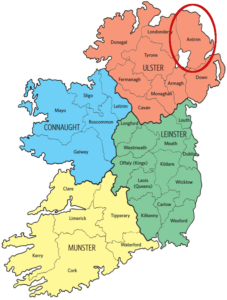 She was born on May 7th, 1819, to James Hannah and Sarah Maxwell in County Antrim,[1] a maritime county in northeastern Ireland. The area was largely composed of Scots-Irish. Given that fact, plus her mother’s surname, and that two of her daughters were married in Presbyterian churches, it seems likely her more distant roots were buried in Scottish soil. For today’s celebration, though, she is Irish through and through. (Just not Catholic Irish — sorry, St. Pat.)
She was born on May 7th, 1819, to James Hannah and Sarah Maxwell in County Antrim,[1] a maritime county in northeastern Ireland. The area was largely composed of Scots-Irish. Given that fact, plus her mother’s surname, and that two of her daughters were married in Presbyterian churches, it seems likely her more distant roots were buried in Scottish soil. For today’s celebration, though, she is Irish through and through. (Just not Catholic Irish — sorry, St. Pat.)
Jane emigrated at the age of 16 with her parents and her brothers, William and James, in 1835 to North America.
What prompted the family’s emigration is unknown, but conditions in Ireland at the time were difficult. The French sociologist, Gustave de Beaumont, who visited Ireland in 1835, wrote:
“I have seen the Indian in his forests, and the Negro in his chains, and thought, as I contemplated their pitiable condition, that I saw the very extreme of human wretchedness; but I did not then know the condition of unfortunate Ireland. … In all countries, more or less, paupers may be discovered; but an entire nation of paupers is what was never seen until it was shown in Ireland.”
Only one-third of Irish laborers had regular work, and conditions in rural areas weren’t any better.
“In most of Ireland, housing conditions were terrible. A census report in 1841 found that nearly half the families in rural areas lived in windowless mud cabins, most with no furniture other than a stool.”[2]
Unfortunately, the escape route across the Atlantic wasn’t much better than the conditions they were leaving. And sadly, Jane’s mother didn’t survive the seven-week voyage to North America, thus was buried at sea. Her death was likely caused or at least exacerbated by the harsh conditions in steerage class on emigrant boats. According to a report to the Colonial Land and Emigration Commission in 1847:
“Before the emigrant has been a week at sea he is an altered man. How can it be otherwise? Hundreds of poor people, men, women and children of all ages, from the driveling idiot of ninety to the babe just born, huddled together without light, without air, wallowing in filth and breathing a fetid atmosphere, sick in body, dispirited in heart, the fever patients lying between the sound, in sleeping places so narrow as almost to deny them the power of indulging, by a change of position, the natural restlessness of the disease. … The food is generally ill selected and seldom sufficiently cooked, in consequence of the insufficiency and bad construction of the cooking places [passengers had to cook their own meals]. The supply of water, hardly enough for cooking and drinking, does not allow washing. In many ships the filthy beds, teeming with all abominations, are never required to be brought on deck and aired: the narrow space between the sleeping berths and the piles of boxes is never washed or scraped, but breathes up a damp and fetid stench, until the day before the arrival at quarantine, when all hands are required to ‘scrub up’ and put on a fair face for the doctor and Government inspector.”
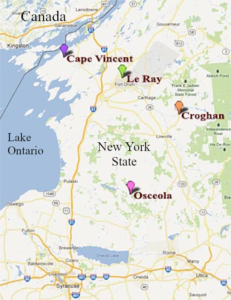
After landing in Quebec, the remaining family traveled up the St. Lawrence River to Sackets Harbor in the Cape Vincent area. The family settled at the farm next to Job Anthony’s, where Jane Hannah kept house for her father. She would have met Barney Anthony in the mid to late 1830s. They were likely married between 1839 and 1840, and had their first child, Sarah, across the river in Canada in 1843. Their second and third daughters were born in Cape Vincent, New York, in 1845 and 1847.
Barney and Jane farmed in upstate New York for a number of years, showing up in censuses in Croghan in 1850, back in Cape Vincent in 1855 (living in a log home with Barney’s 76-year-old father, Job Anthony), and in Osceola township in 1860.
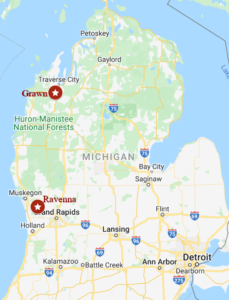 In 1867 Jane and Barney moved their family to a farm in Ravenna Township, just northeast of Grand Haven, on the western side of Michigan. They located across the road from their first-born daughter, Sarah Seymour, whose family had settled there a few years earlier. Most of the farm was densely wooded and dropped steeply to Crockery Creek; the property was picturesque, but not widely arable. In the 1870 census Jane was keeping house and the couple were raising their son Henry, then seven years old, while three of their daughters – Anna (our great-grandmother), Libbie, and Eliza – worked as domestic servants in the surrounding area. Barney was shown to be unable to read or write, while Jane was unable to write.
In 1867 Jane and Barney moved their family to a farm in Ravenna Township, just northeast of Grand Haven, on the western side of Michigan. They located across the road from their first-born daughter, Sarah Seymour, whose family had settled there a few years earlier. Most of the farm was densely wooded and dropped steeply to Crockery Creek; the property was picturesque, but not widely arable. In the 1870 census Jane was keeping house and the couple were raising their son Henry, then seven years old, while three of their daughters – Anna (our great-grandmother), Libbie, and Eliza – worked as domestic servants in the surrounding area. Barney was shown to be unable to read or write, while Jane was unable to write.

At the time of the 1880 census the farm was composed of nine tilled acres for potatoes, corn, oats, and wheat, eight acres of pasture and the remaining 15 acres were wooded or unimproved. There were two horses, nine head of cattle (three of which were milch cows), two pigs, and 25 chickens. After Ireland, this would have felt like paradise.
Barney’s health was never good, and at age 75, in 1886, a doctor found he was stooped, tottering, and suffering from respiratory murmurs in both lungs. That year he was admitted to the newly-opened Michigan Soldier’s Home (he was a Civil War veteran, of sorts) in Grand Rapids, Michigan, with diseases of lungs, liver, and heart as well as partial deafness. He remained in the home until at least 1892, when a doctor’s report also noted senile debility. Fortunately Jane still had their son Henry at home.
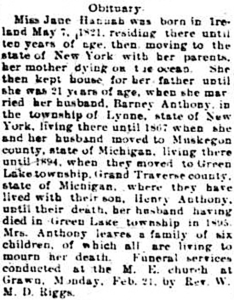
Barney and Jane moved in 1892 or 1893 to Green Lake Township, near Grawn, seven miles south of Traverse City, to live first with their daughter Sarah Seymour and later with their son Henry, who’d bought property and opened a sawmill in Green Lake Township. Barney died in 1893 at age 82 in a state of paralysis. Jane died five years later at age 78 of “old age.” Their bodies were buried next to each other in the Maple Grove Cemetery in Grawn, Michigan. A few years later their infant granddaughter Henrietta was buried next to them.
 As we eat our corned beef and drink our Guinness this St. Patrick’s holiday, we can celebrate our Irish heritage. We can also count our blessings that we have ample food on the table and a warm kitchen, something our Irish kin likely didn’t enjoy back in the old country.
As we eat our corned beef and drink our Guinness this St. Patrick’s holiday, we can celebrate our Irish heritage. We can also count our blessings that we have ample food on the table and a warm kitchen, something our Irish kin likely didn’t enjoy back in the old country.
Here’s to Jane Hannah and her parents …
Sláinte!
Footnotes
1. J. B. Mansfield, ed, History of the Great Lakes, Volume 2: Biographical (Logansport, Indiana: J. H. Beers & Co., 1899), pp 428-429. (Internet Archive) A biography of Jane and Barney’s son-in-law Henry L. Chamberlin reports “On August 13, 1879, Mr. Chamberlin was married to Miss Eliza Anthony, daughter of Barney and Jane (Hannah) Anthony, the latter of whom was from Antrim, a maritime county in the northeast of Ireland, and the principal home of the celebrated Scotch-Irish race. Jane Hannah was a daughter of James and Sarah (Maxwell) Hannah.”
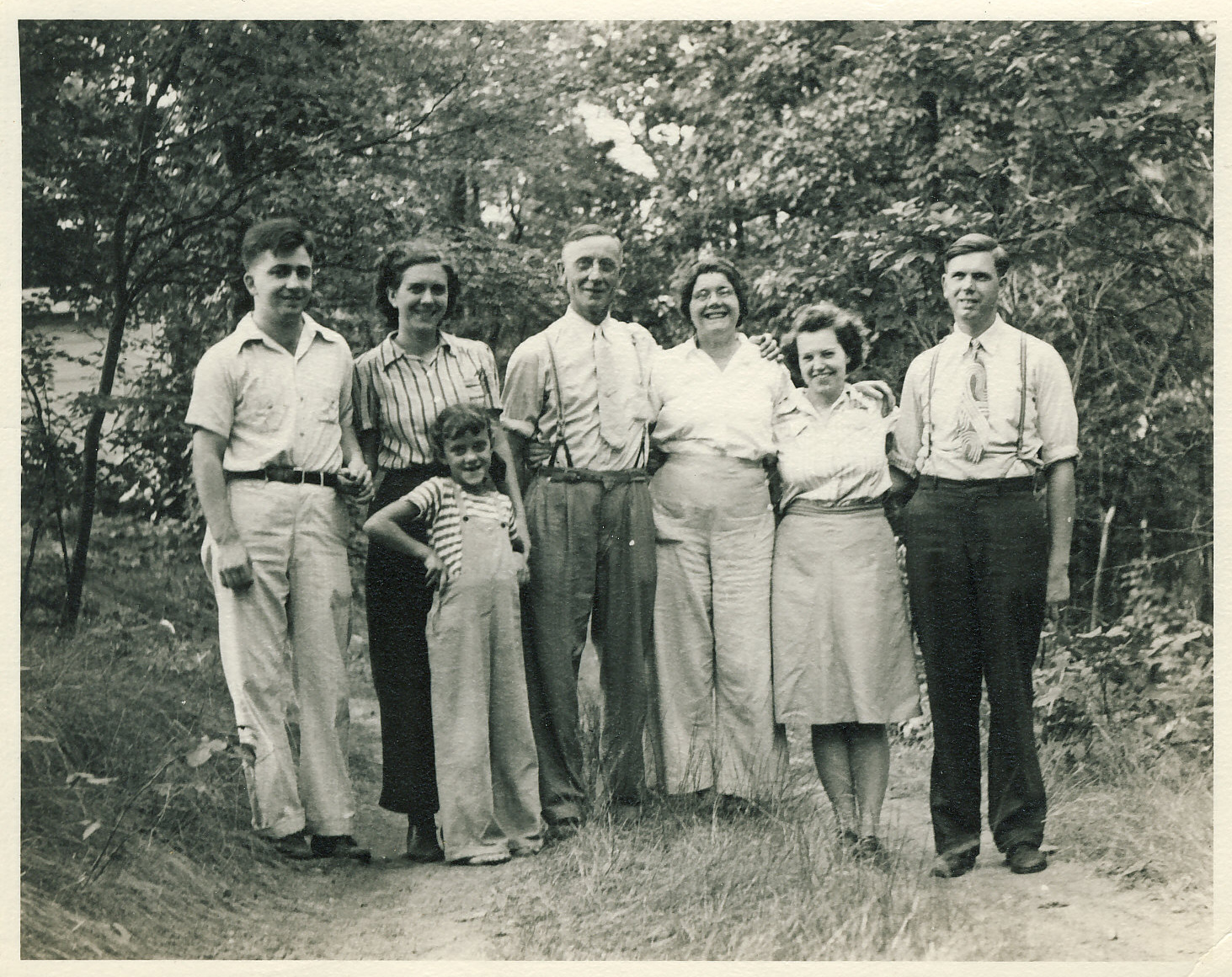
Thank you Jane for making our lives possible. Your move to Michigan helped to give us the opportunity to settle in Detroit.
I have a painting by your granddaughter, Jennie McCrie, hanging in my dining room.